Exchange Currency
Israeli shekel
The Israeli New Shekel is the currency of the State of Israel. The shekel is divided into 100 agorot. Denominations made in this currency are marked with the shekel sign, ₪.
Since January 1, 2003, the sheqel has been a freely convertible currency. Since May 7, 2006, sheqel derivative trading has also been available on the Chicago Mercantile Exchange. This makes the sheqel one of only twenty or so world currencies for which there are widely-available currency futures contracts in the foreign exchange market. It is also a currency that can be exchanged by consumers in many parts of the world.
On May 26, 2008, CLS Bank International (CLS Bank) has announced that it will settle payment instructions in Israeli New sheqel, thus making this currency fully convertible.
The currency is not produced in Israel, as the country has no mint. Currently, the coins are minted at Korea Minting and Security Printing Corporation (KOMSCO), the banknote and coin producer of South Korea, while the banknotes are produced in Switzerland. For a wider history surrounding currency in the region, see The History of British Currency in the Middle East.
In 1986, 100 new shekel notes were introduced, followed by 200 new shekel notes in 1991. The 1, 5 and 10 new shekel notes were later replaced by coins. A plan to issue a 500 shekel banknote, carrying the portrait of Yitzhak Rabin, was announced shortly after Rabin's assassination in 1995. However, due to low inflation rates, there was no need for such a banknote, and it was never issued. However, in February 2008 the Bank of Israel announced that the planning of an entirely new series of banknotes has started, and that the new series, to be issued in 2010, will most probably include a 500 shekel banknote as well.
Though still not decided officially, the new series is likely to consist of polymer notes only. In December 2009 the Bank of Israel announced a new series to be issued in 2012, which would bear the images of Theodore Herzl, David Ben Gurion, Menachem Begin and Yitzhak Rabin. The plan to issue a 500 shekel note was officially abandoned. The announcement was publicly received with criticism, and a few days later, the governor of the Bank of Israel announced that the issue be returned for further discussions. The committee suggested that the new series would include prominent Hebrew poets and poetesses, and named Rachel Bluwstein, Shaul Tchernichovsky, Leah Goldberg and Nathan Alterman as the figures that should appear on the notes. The governor decided to adopt only part of the suggestion, and in December 2010 announced that the series would include Begin, Rabin, Shmuel Yossef Agnon and Rachel Bluwstein. Owing to further criticism and Begin's family reluctance to approve the decision, the governor decided to return to the committee's original proposal, and the Israeli government approved it.
Reports in April 2011 suggest that the Bank of Israel also plans to issue a new series of coins, and adopt designs that would lower expenses by using less metal. In addition, the new series is supposed to make counterfeit harder. The Bank of Israel is also considering to drop the adjective "new" from the currency's name on the planned coins series. If approved, this would be the first replacement of all coins since the introduction of the new shekel coins in September 1985.
Summary info
Summary information about Israeli shekel- ISO 4217 Code:
- ILS
- Currency sign:
- ₪
- Country:
- Israel, Palestinian territories
- Subunit:
- agora
- Coins:
- 10 agorot, ½ new shekalim, 1 new shekalim, 2 new shekalim, 5 new shekalim, 10 new shekalim
- Banknotes:
- 20 new shekalim, 50 new shekalim, 100 new shekalim, 200 new shekalim
- Central bank:
- Bank of Israel
History
The old sheqel suffered from runaway inflation during the economic crisis which occurred in Israel in the early 1980s. After inflation was finally contained by the middle of the decade as a result of the 1985 Economic Stabilization Plan, the new sheqel was introduced, replacing the old sheqel on January 1, 1986, at a rate of 1,000 old sheqalim = 1 new sheqel.Since January 1, 2003, the sheqel has been a freely convertible currency. Since May 7, 2006, sheqel derivative trading has also been available on the Chicago Mercantile Exchange. This makes the sheqel one of only twenty or so world currencies for which there are widely-available currency futures contracts in the foreign exchange market. It is also a currency that can be exchanged by consumers in many parts of the world.
On May 26, 2008, CLS Bank International (CLS Bank) has announced that it will settle payment instructions in Israeli New sheqel, thus making this currency fully convertible.
The currency is not produced in Israel, as the country has no mint. Currently, the coins are minted at Korea Minting and Security Printing Corporation (KOMSCO), the banknote and coin producer of South Korea, while the banknotes are produced in Switzerland. For a wider history surrounding currency in the region, see The History of British Currency in the Middle East.
Coins
In 1985, coins in denominations of 1, 5 and 10 agorot, ½ and 1 new sheqel were introduced. In 1990, 5 new sheqalim coins were introduced, followed by 10 new sheqalim in 1995. Production of 1 agora pieces ceased in 1990 too, and they were removed from circulation on April 1, 1991. A 2 new sheqalim coin was introduced on December 9, 2007. The 5 agorot coin, last minted in 2006, was removed from circulation on January 1, 2008.Banknotes
In September 1985, banknotes were introduced in denominations of 1, 5, 10, 20 and 50 new shkalim. The 1, 5 and 10 new shekel notes used the same basic designs as the earlier 1,000, 5,000 and 10,000 old shekel notes but with the denominations altered.In 1986, 100 new shekel notes were introduced, followed by 200 new shekel notes in 1991. The 1, 5 and 10 new shekel notes were later replaced by coins. A plan to issue a 500 shekel banknote, carrying the portrait of Yitzhak Rabin, was announced shortly after Rabin's assassination in 1995. However, due to low inflation rates, there was no need for such a banknote, and it was never issued. However, in February 2008 the Bank of Israel announced that the planning of an entirely new series of banknotes has started, and that the new series, to be issued in 2010, will most probably include a 500 shekel banknote as well.
Though still not decided officially, the new series is likely to consist of polymer notes only. In December 2009 the Bank of Israel announced a new series to be issued in 2012, which would bear the images of Theodore Herzl, David Ben Gurion, Menachem Begin and Yitzhak Rabin. The plan to issue a 500 shekel note was officially abandoned. The announcement was publicly received with criticism, and a few days later, the governor of the Bank of Israel announced that the issue be returned for further discussions. The committee suggested that the new series would include prominent Hebrew poets and poetesses, and named Rachel Bluwstein, Shaul Tchernichovsky, Leah Goldberg and Nathan Alterman as the figures that should appear on the notes. The governor decided to adopt only part of the suggestion, and in December 2010 announced that the series would include Begin, Rabin, Shmuel Yossef Agnon and Rachel Bluwstein. Owing to further criticism and Begin's family reluctance to approve the decision, the governor decided to return to the committee's original proposal, and the Israeli government approved it.
Reports in April 2011 suggest that the Bank of Israel also plans to issue a new series of coins, and adopt designs that would lower expenses by using less metal. In addition, the new series is supposed to make counterfeit harder. The Bank of Israel is also considering to drop the adjective "new" from the currency's name on the planned coins series. If approved, this would be the first replacement of all coins since the introduction of the new shekel coins in September 1985.
ILS banknotes pictures gallery
| 20 Israeli shekalim | |
|---|---|
| Banknote of 20 Israeli shekalim has dimensions 138×71 mm and main colors are dark gray, splashed white, feldgrau and dark sea green. Date of issue of 20 New Shekalim banknote was January 3, 1999. | |
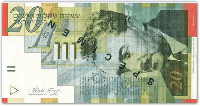 Obverse side of the 20 Israeli shekalim is showing the portrait of Moshe Sharett and a picture of the ceremony of the unfurling of the Israeli flag at the UN building on May 12, 1949. |
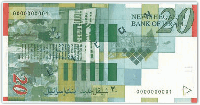 Reverse side of the 20 Israeli shekalim is showing a picture of Agnon's writing stand with his pen and reading glasses. Text lists the titles of sixteen of Agnon's books. |
| 50 Israeli shekalim | |
|---|---|
| Banknote of 50 Israeli shekalim has dimensions 138×71 mm and main colors are bazaar, languid lavender, floral white, gainsboro and light taupe. Date of issue of 50 New Shekalim banknote was October 31, 1999. | |
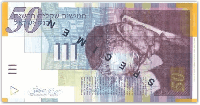 Obverse side of the 50 Israeli shekalim is showing the portrait of Shmuel Yosef Agnon; picture of Agnon's study and personal library. Text from the acceptance address given by Agnon when he was awarded the Nobel Prize for Literature in 1966. |
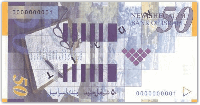 Reverse side of the 50 Israeli shekalim is showing a picture of Agnon's writing stand with his pen and reading glasses. |
| 100 Israeli shekalim | |
|---|---|
| Banknote of 100 Israeli shekalim has dimensions 138×71 mm and main colors are umber, cinereous, champagne and pastel gray. Date of issue of 100 New Shekalim banknote was January 3, 1999. | |
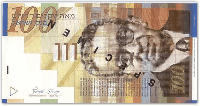 Obverse side of the 100 Israeli shekalim is showing the portrait of Itzhak Ben-Zvi and a picture of the interior of the wooden structure which served as the President's residence. Text from the speech given by Ben-Zvi at the first assembly of the Yemenite community held at his residence in 1953. |
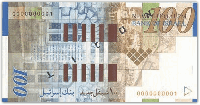 Reverse side of the 100 Israeli shekalim is showing a picture of synagogue in the Galilee village of Peki'in and a view of Peki'in. Text from Ben-Zvi's speech at the inauguration for his second term. |
| 200 Israeli shekalim | |
|---|---|
| Banknote of 200 Israeli shekalim has dimensions 138×71 mm and main colors are terra cotta, dark salmon, lemon chiffon and antique brass. Date of issue of 200 New Shekalim banknote was October 31, 1999. | |
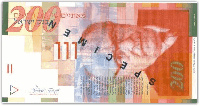 Obverse side of the 200 Israeli shekalim is showing the portrait of Zalman Shazar and a picture of pupils in an elementary school class. Text from Shazar's address to the Knesset on July 13, 1949, after the Compulsory Education Law was passed. |
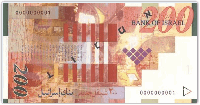 Reverse side of the 200 Israeli shekalim is showing a picture of a typical alley in the town of Safed - a spiritual center of Kabbalists. |
Useful links
- About Bank of Israel:
- Bank of Israel
- List of currencies:
- Currencies
- Security and design features of ILS banknotes:
- ILS banknotes
- ILS currency on Wikipedia:
- Israeli shekel
- Official Website of Bank of Israel:
- bankisrael.gov.il
- Commemorative coins:
- Commemorative Coins